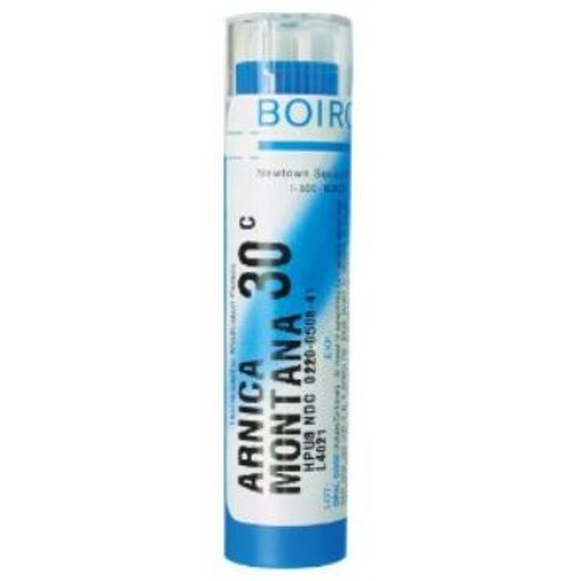Sooner or later we all experience a traumatic physical injury from a fall; contact during sports; from a dental procedure or surgery; or twisting or straining joints or muscles. While over the counter pain relievers like Acetaminophen (Tylenol) or Ibuprofen reduce pain they come with a list of potentially serious side effects.
Fortunately, there is an excellent homeopathic remedy that can safely be used by anyone and brings with it zero drug interactions! That remedy is made from the herb Arnica Montana or Arnica for short. It is also known as Leopard’s Bane, Mountain Tobacco or Wolf’s Bane. In addition to its pain-relieving properties, Arnica also reduces inflammation from traumatic injury.
In fact, it is so successful in reducing inflammation, bruising and swelling from traumatic injury that it is routinely prescribed by plastic surgeons because excess post-surgery inflammation and swelling can negatively affect the results of these surgeries.
Arnica is a flowing perennial plant related to the Daisy and Sunflower – so those with allergies to either of these flowers should avoid using the actual herb.
Homeopathic Arnica is derived from the herb but like all homeopathic remedies is NOT the same as an herbal remedy. To produce homeopathic Arnica the herb is harvested, chopped up and placed in a container with alcohol and left for approximately one month. Then the particulate matter is strained out so that the alcohol is left which acts as a solvent and is full of all the plant chemicals from Arnica.
This liquid is known as “Mother Tincture”. Next, they take one drop of this liquid and mix it with either 9 drops or 99 drops of alcohol and the mixture is shaken through a particular process known as succession. The dilution is now either 1 part per 10 or 1 part per 100. This process is repeated again using the diluted mixture – one drop mixed with either 10 drops or 100 drops. The liquid is then poured onto small pellets of lactose. Depending on how many times this process is repeated determines a homeopathic remedy’s “potency” and there are several potency scales used in homeopathy:
Decimal potencies which come marked as 3X, 6X, 100X, etc. Centesimal potencies which come marked as 3C, 9C, 12C, 30C, or 1M(1,000 dilutions) and 10M (10,000 dilutions)
So How Do Homeopathic Remedies Produce Effects Since They are so Diluted?
The key to understanding how homeopathic remedies work is understanding the process of hormesis. Hormesis refers to a biphasic dose response to a chemical whereby an extremely low dose can cause stimulation and beneficial effect on a biological system and a higher dose can cause an inhibitory or toxic effect. Put another way hormesis refers to the fact that a beneficial effect (improved health, stress tolerance, growth or longevity) can result from exposure to low doses of an agent that is other toxic at higher doses.
There are many examples of hormesis including physical stress from lifting weights – provide enough load and stress and not too much and the body gets stronger – try to lift too much weight or do too much weight lifting too soon and injury results.
In the case of many beneficial plant chemicals – these phytochemicals are actually known toxins which at high doses produce negative or toxic effects but at low doses stimulate a positive adaptive response by the body.
So - dose is VERY important!
How do you use Arnica for injuries?
Homeopathic Remedies are produced in strict compliance with pharmaceutical Good Manufacturing Processes in FDA inspected facilities. They usually come in small tubes full of pellets of lactose with a twist top that allows you to select 3 – 5 pellets. You simply place them under your tongue and allow them to dissolve. Dosage instructions are included on the tubes and a tube of homeopathic Arnica is very inexpensive - $6 - $9 for many doses worth!
To treat any traumatic injury, take 3 – 5 pellets and repeat as often as every 15 minutes until you feel improvement. There is no possibility of overdose or poisoning. The best potency for most injuries is 30C but any potency you find will work. For really serious injuries look for 200C potency.
Once you experience how effective this remedy can be you will want to have it with you all the time!
Topical Arnica
Arnica can also be used topically and comes in the form of gels, creams, liquids. This form of Arnica is herbal meaning that it DOES contain significant quantities of plant chemicals from Arnica, and it is proven to be highly effective for traumatic injury. It should NOT be used on any broken skin, and no form of herbal Arnica should every be taken internally!
You can use both topical Arnica and homeopathic Arnica in cases like sprains, strains and impact injuries without broken skin.





